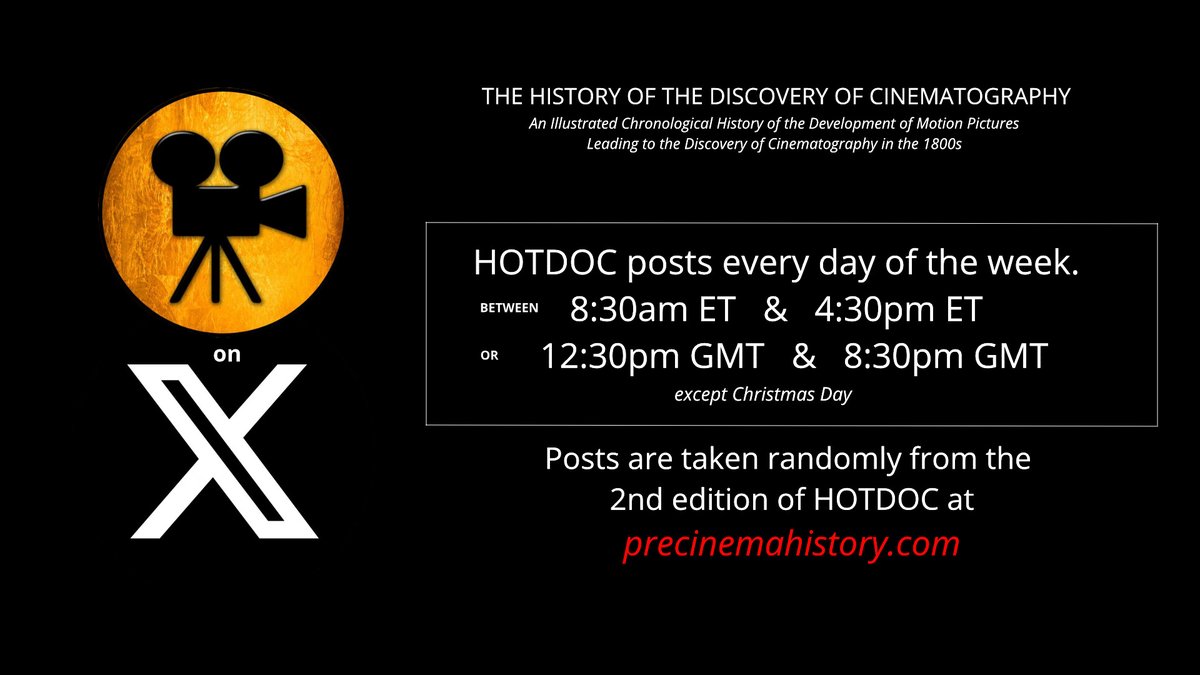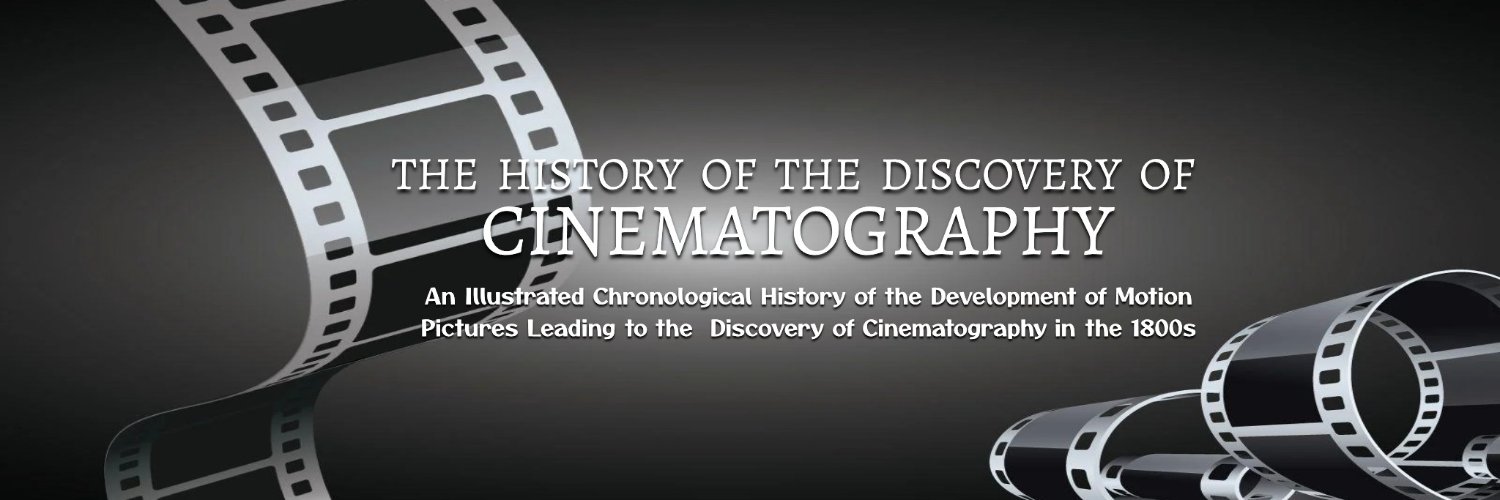
Pre Cinema History 📷🎞️🇨🇦 🏴
@RealPreCinema
Paul Burns, Pre Cinema Historian, Autodidact. Author of THE HISTORY OF THE DISCOVERY OF CINEMATOGRAPHY I post daily.
5/5 So, while he might not be as widely known as some later pioneers of pre cinema, T. W. Naylor played a crucial role in the development of animated projection, combining existing technologies to push the boundaries of visual entertainment and helping to pave the way for future…
Naylor’s device presented sequenced pictures painted around a glass disk of a flower blooming. This is perhaps the first known application for showing sequential moving pictures twelve years after Plateau and Stampfer. Naylor further described his disks providing the motion of;…
N.B. “Note that the placard shown might be incorrect, as Birnie probably only did the aquatint, Henry Barker the etching.” - Andrew Taylor Chapter seven is where my #RobertBarker Panorama entry resides precinemahistory.com/chapter-seven/… -30-
EXPERIENCE an amazing interactive 360° Panoramic view of Robert Barker’s painting of London in the Winter of 1790-1791. Don’t get dizzy! Thanks to Andrew Taylor @agrahamt ➡️ renlyon.org/london1790/ind…
EXPERIENCE an amazing interactive 360° Panoramic view of Robert Barker’s painting of London in the Winter of 1790-1791. Don’t get dizzy! Thanks to Andrew Taylor @agrahamt ➡️ renlyon.org/london1790/ind…
TRUE CIRCULAR PANORAMA This Panorama was taken from the top of the Edinburgh Camera Obscura @camobscura. Peter Stubbs photograph. The Castle at both ends makes it about 375°. This Panoramic photograph is 4,412 × 481 pixels. SEE it in my 1st edition precinemahistory.net/edinburgh3.htm
TRUE CIRCULAR PANORAMA This Panorama was taken from the top of the Edinburgh Camera Obscura @camobscura. Peter Stubbs photograph. The Castle at both ends makes it about 375°. This Panoramic photograph is 4,412 × 481 pixels. SEE it in my 1st edition precinemahistory.net/edinburgh3.htm
Here is a 2004 Panoramic photograph taken from the Scott Monument of the city of Edinburgh. Photograph by John Loughlin. In Germany, Barker’s Panorama had an unfortunate translation of, Nausorama. SEE a FULL digitised copy here in my 1stedition precinemahistory.net/edinburgh2.htm
Here is a 2004 Panoramic photograph taken from the Scott Monument of the city of Edinburgh. Photograph by John Loughlin. In Germany, Barker’s Panorama had an unfortunate translation of, Nausorama. SEE a FULL digitised copy here in my 1stedition precinemahistory.net/edinburgh2.htm
Left A cut-away illustration of Barker’s famed double-decker Panorama in #LeicesterSquare, London, 1793. These enormous paintings were a precursor to today's wide-screen Cinema. The #BarkerPanorama was as wide as 300 feet and as high as 50. Right Barker’s Panorama of London,…
Left A cut-away illustration of Barker’s famed double-decker Panorama in #LeicesterSquare, London, 1793. These enormous paintings were a precursor to today's wide-screen Cinema. The #BarkerPanorama was as wide as 300 feet and as high as 50. Right Barker’s Panorama of London,…
This Panorama by Barker is from The #Edinburgh Virtual Environment Centre at The University of Edinburgh, © the City Arts Centre. Entitled ‘Edinburgh from the Crown of St. Giles.’ Thanks to John Hadden. SEE a FULL digitised copy here in my 1st edition precinemahistory.net/edinburgh.htm
This Panorama by Barker is from The #Edinburgh Virtual Environment Centre at The University of Edinburgh, © the City Arts Centre. Entitled ‘Edinburgh from the Crown of St. Giles.’ Thanks to John Hadden. SEE a FULL digitised copy here in my 1st edition precinemahistory.net/edinburgh.htm
1792 Barker makes his first public presentation of his new Panorama at Leicester Square, London in 1792. Patrons sat in the centre of a slowly revolving rotunda, which measured 16 feet high and 45 feet in diametre. Barkers 'View of London,' below.
1792 Barker makes his first public presentation of his new Panorama at Leicester Square, London in 1792. Patrons sat in the centre of a slowly revolving rotunda, which measured 16 feet high and 45 feet in diametre. Barkers 'View of London,' below.
1787 THE EMERGENCE OF WIDE SCREEN CINEMA ROBERT BARKER (1739-1806) Barker patents a form of entertainment which contained huge painted pictures. It is recorded on the patent as "an entire new contrivance or apparatus called by him 'La nature a coup d' Oeil.'
1787 THE EMERGENCE OF WIDE SCREEN CINEMA ROBERT BARKER (1739-1806) Barker patents a form of entertainment which contained huge painted pictures. It is recorded on the patent as "an entire new contrivance or apparatus called by him 'La nature a coup d' Oeil.'
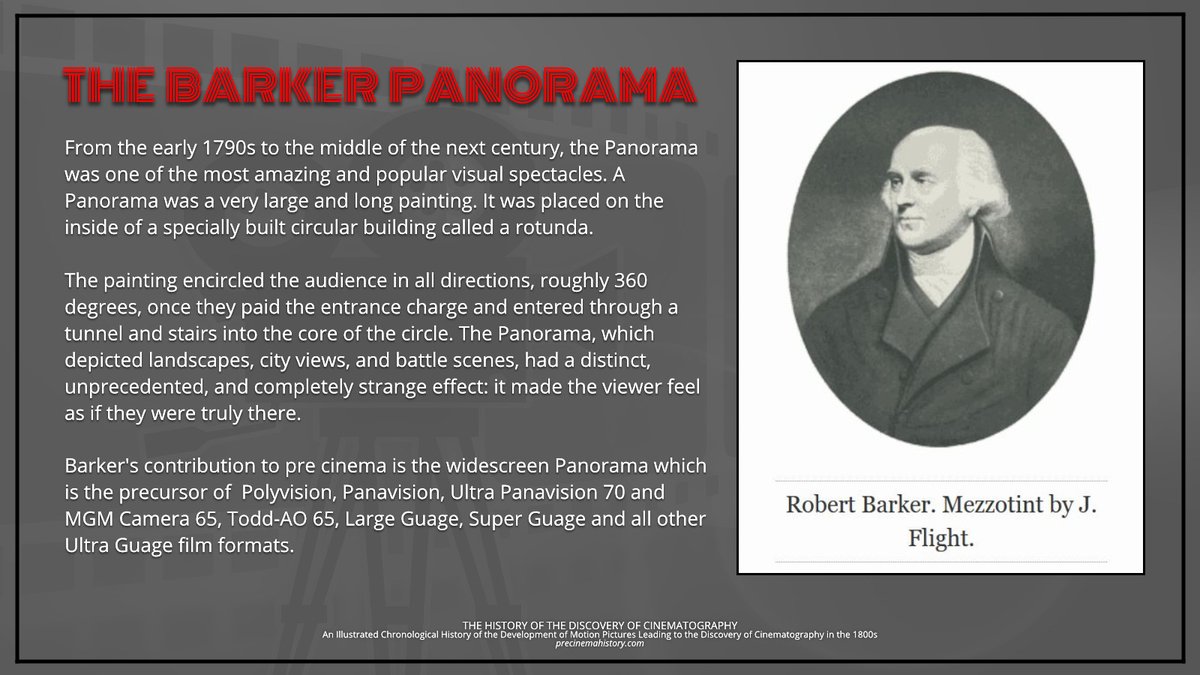
5/5 Here is how the Kinemacolor process appeared projected using the red-green filter process. precinemahistory.com/chapter-eighte… -30-
This is a Kinemacolor Motion Picture Camera identified by historian/collector Sam Dodge as Nº 108 off the production line, from the Sam Dodge Collection.
This is a Kinemacolor Motion Picture Camera identified by historian/collector Sam Dodge as Nº 108 off the production line, from the Sam Dodge Collection.
A coloured schematic series showing how the two-colour Kinemacolor additive motion picture process operated, from Jack H. Coote’s, ‘The Illustrated History of Colour Photography,’ Surrey Fountain Press, 1993.
A coloured schematic series showing how the two-colour Kinemacolor additive motion picture process operated, from Jack H. Coote’s, ‘The Illustrated History of Colour Photography,’ Surrey Fountain Press, 1993.
On the left is the colour disk on the Smith co-developed Kinemacolor. Image Brian Pritchard. Right, an illustration of the original design of the camera. Source Kinemacolor Handbook Charles Urban, 1910, London. The Natural Color Kinematograph Company Ltd.
On the left is the colour disk on the Smith co-developed Kinemacolor. Image Brian Pritchard. Right, an illustration of the original design of the camera. Source Kinemacolor Handbook Charles Urban, 1910, London. The Natural Color Kinematograph Company Ltd.
GEORGE ALBERT SMITH (1864-1959) Film pioneer #GeorgeAlbertSmith below, made one of the first spooky films Photographing a Ghost, now thought lost. It could be considered a precursor to the paranormal investigation sub-genre. This lost film portrays three men who attempt to…
GEORGE ALBERT SMITH (1864-1959) Film pioneer #GeorgeAlbertSmith below, made one of the first spooky films Photographing a Ghost, now thought lost. It could be considered a precursor to the paranormal investigation sub-genre. This lost film portrays three men who attempt to…
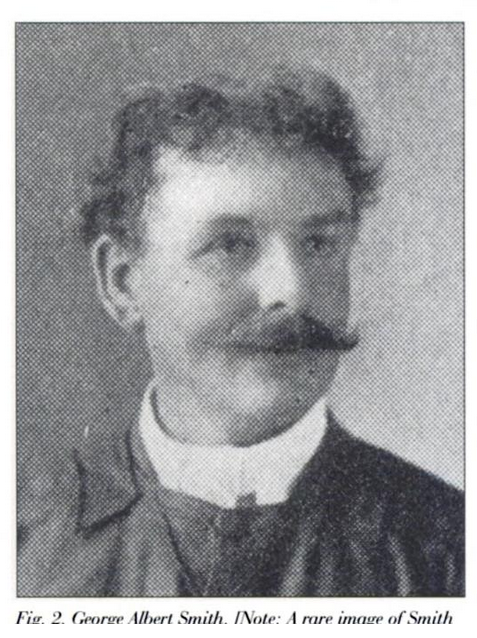


This Day in Buster…July 27, 1882 Donald Crisp is born. The ‘director’ of “The Navigator,” Buster Keaton told him the picture was finished just so he’d leave & he could reshoot it. Donald’s face was immortalized however, in this scene… #oldhollywood #busterkeaton #damfino
2/2 Maxwell took three separate photographs through each filter. The composite resulted in the first colour photograph. Maxwell was 30 years of age at the time. The subject of the photograph was a ribbon of tartan and is known as Tartan Ribbon. The shutter was pressed by Thomas…
1861 JAMES CLERK MAXWELL (1831-1879) One of the great physicists and scientists, this Scot wrote his first scientific paper when he was 14. He produced the first documented colour photograph by using red/yellow/blue filters (other sources say the third filter was green). This…
1861 JAMES CLERK MAXWELL (1831-1879) One of the great physicists and scientists, this Scot wrote his first scientific paper when he was 14. He produced the first documented colour photograph by using red/yellow/blue filters (other sources say the third filter was green). This…
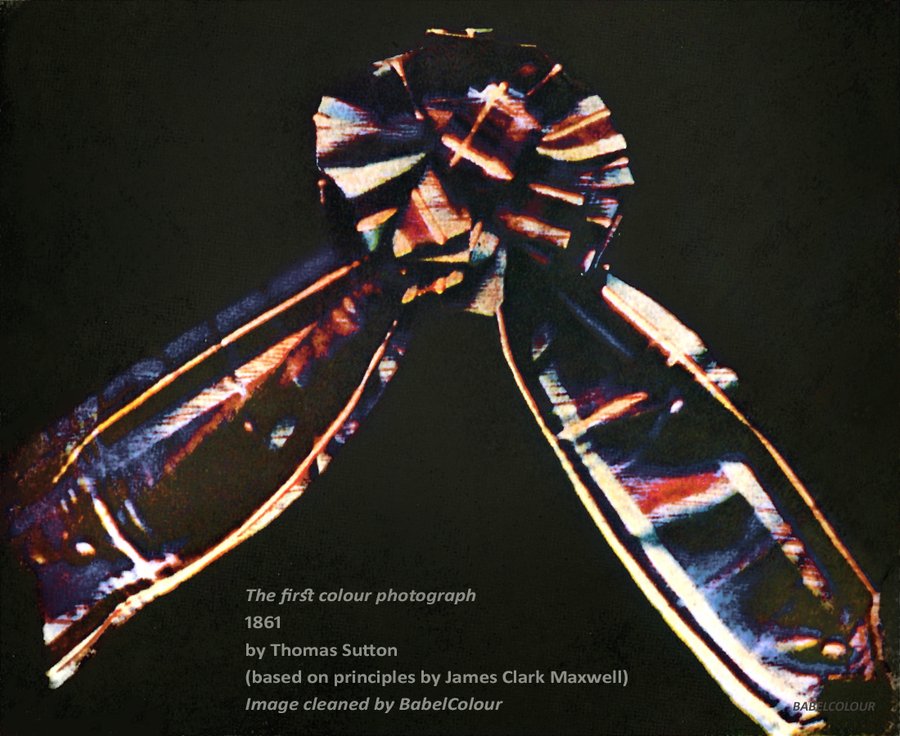
Sounds good
It is using these principles that Muybridge would exhibit his zoopraxiscopic images some years later, right?
Naylor’s device presented sequenced pictures painted around a glass disk of a flower blooming. This is perhaps the first known application for showing sequential moving pictures twelve years after Plateau and Stampfer. Naylor further described his disks providing the motion of;…
Naylor’s letter provided a complete legend within his sketch, as well as a full description of the workings of it. It was published in the 7 January – 24 July issue, 1843 on pp319, 320. His innovation was to integrate the sequential animation of the Phenakistiscope with the…
Naylor’s letter provided a complete legend within his sketch, as well as a full description of the workings of it. It was published in the 7 January – 24 July issue, 1843 on pp319, 320. His innovation was to integrate the sequential animation of the Phenakistiscope with the…
Naylor’s letter contained only his words and his sketch. His projections suggest “images forming,” even though there’s no description of how they could be animated in an "authentic and faithful" way. Naylor continues “In each repetition, the figures are gradually changing…
